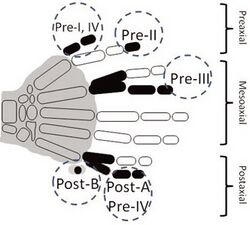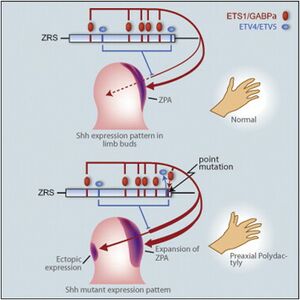|
|
|
Welcome to Genes and Development GN434! Contribute something by using the edit button above!
From Genes and Development GN434IntroductionPolydactyly is a condition characterized by the formation of an excess number of digits (Polydactyl stems from the greek words polys, meaning many, and dactylos, meaning fingers). It is one of the most common forms of limb defect, and roughly 300 distinct malformations have been associated with an array of genes to produce the polydactyl phenotype (Malik 2014). This congenital defect is present from birth and the extra digits can vary in form from being small and non-functional to fully formed and functional. Polydactyly can occur in humans (twice as often in males than in females), dogs, cats, chickens, and other mammals. Polydactyly exists in three variants; Preaxial (radial), Postaxial (ulnar), and the third variation is Central polydactyly. Preaxial polydactyly has the extra digits formed prior to the thumb, Postaxial forms the extra digit after the pinkie, and Central forms the extra digit in the middle of the “normal” fingers. Polydactyly can arise by a variety of means. It can occur on its own as a result of a single genes autosomal dominant mutation, or it can occur as a byproduct of syndromes like: McKusick–Kaufman syndrome, Down syndrome, Bardet–Biedl syndrome (Buck-Gramcko 1998), and many other syndromes. In the case of the single gene mutation, the mutation is linked the ectopic expression of an early developmental molecule called Sonic Hedgehog. The gene that codes for this molecule (Shh) is controlled by a limb-specific cis-regulator called the ZRS. Within the ZRS lies a region of ~800 bp of conserved noncoding elements (CNEs) that can be found in a multitude of different species across great evolutionary distances (Lettice et al. 2008). CNEs are of particular importance because they are often associated with genes that perform a critical function. In the paper Point mutations in a distant sonic hedgehog cis-regulator generate a variable regulatory output responsible for preaxial polydactyly, Lettice and her colleagues explore the effects of different single gene mutations and species-specific ZRS regions and their patterns of ectopic expression in transgenic mice. Background Hemingway with one of his beloved polydactyl cats; source: http://www.brainpickings.org/wp-content/uploads/2012/07/hemingwayscats1.jpg Ernest Hemingway was a cat lover and was gifted a six-toed Maine Coon cat from Key West, which is the ancestor of some of the cats that reside in the Hemingway Museum today. These cats have become so well known that polydactyl cats are often nicknamed “Hemingway Cats” in honor of Hemingway's legacy and general love for felines (Syufy). Researchers are interested in studying polydactyly mutations because they present a new genetic mechanism that gives rise to human congenital abnormalities, and are linked to a pathogenetic mechanism that could cause other congenital diseases. These mutations are variable dependent upon their location within the ZRS sequence, and do not appear to require complex molecular modification, as specific point mutations cause the recognizable changes to the limb; cis-regulatory elements can mutate a limb in one step. This makes the mutations easier to identify and study within the sequence and organism. (Lettice et al 2008). There are a number of known point mutations associated with polydactyly in humans. Depending on their position within the regulatory elements, the observed phenotype can vary widely in severity. For example, a family of mutations known as the Cuban mutation is characterized by extensive limb abnormalities including triphalangial thumbs, hexadactyly, radial dysplasia, or bilateral absence of the tibia (Lettice et al. 2008). Alternatively, the Belgian2 mutation can have as mild a phenotype as a small "nubbin," but never fully formed fingers. In vertebrate biology, conserved noncoding elements (CNEs) are especially important, as they are often linked to genes that are vital to key developmental processes across wide evolutionary distances. An example of a developmental CNE is in relation to the signalling molecule sonic hedgehog (SHH) that is regulated by these modular elements, specifically the ZRS (Lettice et al 2008). The ZRS is the cis-regulator that is responsible for polydactyl mutations in cats, as it regulates the expression of Shh in the developing limb bud, specifically in the domain called the zone of polarizing activity (ZPA) on the posterior of the limb bud. The expression of Shh in the ZPA will determine the number and identity of the digits present (Lettice et al 2008). Concerning human biology, human preaxial polydactyly (PPD) includes a wide variety of digit abnormalities on the anterior sides of the hands and feet, and is observed in mouse models as well. The mouse models used demonstrated the genetic basis of PPD, in that they showed it results from ectopic expression of Shh at the anterior side of the limb bud, the opposite side of the ZPA (Lettice et al 2008). The data supports that PPD is a regulatory disorder from mutations within the ZRS, which will result in the misexpression of Shh, forming an ectopic ZPA, creating extra digits. This also indicates that both human and mice polydactyl mutations occur within the ZRS. Analysis of polydactylous cats will add to the list of mutations that are associated with this physical abnormality (Lettice et al 2008). Materials and MethodsPhase 1: Survey to extend the number of known mutations in the ZRS element A number of mutations in the ZRS region have been identified in mammals. To expand the breadth of mutations that occur in this region and compare their effects between species, an effort was undertaken to sequence the ZRS region of the well-known polydactyl cats found in Ernest Hemingway’s home of Key West, Florida (Lettice et al. 2008). To establish a control, the wild-type cat ZRS region was sequenced from 5 unrelated cats and no mutations were present in the CNE. The ZRS region was then sequenced from North American polydactyl cats (4 from the Hemingway colony, 2 from elsewhere), and all affected cats had an A to G mutation at the 479th bp in the CNE (which is now referred to as the Hw mutation). There also exists smaller populations of polydactyl cats in Great Britain, so the ZRS region was sequenced from 8 British polydactyl cats. From these sequences, they found two new mutations in the CNE (UK1 and UK2) that were different from the Hw mutation. This brings the total to 13 known point mutations that cause polydactyly in humans, mice, and cats. Phase 2: Mouse Transgenic Assays Now that the researchers had consistent point mutations across multiple species, they created a variety of transgenic mice which contained different combinations of mutations and ZRS regions to see if the effects of these mutations were exclusive to a species or a specific sequence in the Shh cis-regulator (Lettice et al. 2008). The researches wanted to demonstrate that both the specific mutation as well as the "sequence context" the mutation was found in (the different ZRS regions) contributed to the phenotypic variance associated with polydactyly. The following transgenic embryos were created using site directed mutagenesis and DNA microinjection. LacZ was used as a reporter gene to track expression (simulating Sonic Hedgehog (Shh)): • A mouse containing the mouse ZRS region with the different human mutations (Cuban, Belgian2) • A mouse containing the human ZRS region with the different human mutations • A mouse containing the mouse ZRS region with the different mouse mutations (M100081, Hx) • A mouse containing the cat ZRS region with two of the different cat mutations (Hw and UK2) • A mouse containing the mouse ZRS region with the two different cat mutations was created To test if the region in which the mutations occur is a functional unit, the researchers created an additional transgenic mouse embryo in which the adjacent nucleotide on the 5’ side of the Hx mutation (which is a mouse mutation) was mutated from T to C (Lettice et al. 2008). Results and Significance An Hw mutant; source: http://en.wikipedia.org/wiki/Polydactyl_cat#mediaviewer/File:PawPed-1A.jpg The results showed that all of the affected cats had an identical nucleotide substitution where a cytosine was converted into a guanine at the exact same point (base 479 to be exact). This nucleotide substitution was titled the Hw mutation. Of the cats which were sampled, two were heterozygous and one was homozygous. The homozygote did not show any more severity in its phenotype when compared to the heterozygote (Lettice et al. 2008). When other cats across North America were examined, they were all found to have the exact same nucleotide substitution as well. When cats from Britain were also examined, they lacked the Hw mutation which all of the North American cats had. Instead, the British cats all contained two different point mutations which were titled UK1 (at base 257) and UK2 (at base 481). Through these two different mutations it was shown that polydactyl had evolved multiple times within the cat genome. The fact that the UK2 and the Hw base pairs were only two bases apart from one another leads to the belief that the triplet encoded by these genes has a large effect on the Shh gene during limb development. Through the use of a mouse transgenic assay two different human ZRS point mutations were examined (Cuban and Belgian2) which represent the extremes of human polydactyly. The transgenic assay using mouse ZRS with the human mutations showed the expected pattern of ectopic expression based on human phenotypes; additionally, the level of Shh expression using the Cuban mutation was significantly higher than the Belgian2 mutation (Lettice et al. 2008). It can be inferred that expression levels are correlated with observed severity. When the mouse genome was transformed with the human ZRS, the outcome was somewhat different. Some embryos only showed expression at the posterior end and some showed it on the anterior portion of the limb as well. The M100081, which is located two nucleotides directly downstream from the Cuban mutation, causes a shortened tibia in the affected individuals. The Hx mutation causes twisting of the forearm and a shortened tibia and fibula. When the modified ZRS containing the M100081 was examined, it had strong expression along the anterior portion of the limb bud which is similar to the Cuban mutation's expression. This data shows that the method for misexpression in limbs is the same in both mice and humans and that there is a distinct correlation between the genes examined and the phenotypes seen. Cats which contain the Hw mutation are only affected on the forelimbs, while cats which have the UK2 mutation are affected on all four limbs (Lettice et al. 2008). The assay which was performed showed expression of the Hw mutation predominantly in the forelimbs during development while the UK2 mutation showed expression in all limbs during development thus proving that the Hw mutation is forelimb specific. While the UK2 and Hw mutations do occur within the same triplet, they give different ectopic expression patterns within development. This is more than likely due to the surrounding nucleotides since a three base pair site on DNA is relatively small for a protein binding site. This means that both position and sequence influence how the mutation affects the phenotype. The data infers that polydactyl point mutations all occur within the ZRS regions of cats, humans, and mice, and that a single point mutation in this region is sufficient for producing the polydactyl phenotype (Lettice et al. 2008). The data specifically showed that the point mutation does not inactivate the gene in question, but instead alters the expression of the gene entirely. Because of the variability of the location of the mutations and severity of phenotypes, it is probable that the entirety of the ZRS is involved in a cis-acting regulatory mechanism that interacts with or is regulated by other pathways. Understanding the effects and interactions of SNPs is becoming increasingly important and useful as more diseases are attributed to single, common mutations. ReferencesLettice, L. A., Hill, A. E., Devenney, P. S., & Hill, R. E. (2008). Point mutations in a distant sonic hedgehog cis-regulator generate a variable regulatory output responsible for preaxial polydactyly. Human Molecular Genetics, 17(7), 978-985. doi:10.1093/hmg/ddm370 Lettice, L. A., Williamson, I., Wiltshire, J. H., Peluso, S., Devenney, P. S., Hill, A. E., . . . Hill, R. E. (2012). Opposing functions of the ETS factor family define Shh spatial expression in limb buds and underlie polydactyly. Developmental Cell, 22(2), 459-467. doi:10.1016/j.devcel.2011.12.010 Buck-Gramcko, D. (1998) "Congenital Malformations of the Hand and Forearm." Churchill-Livingstone Malik, S. (2014). Polydactyly: Phenotypes, genetics, and classification. Clinical Genetics, 85, 203-212. doi: 10.1111/cge.12276 Syufy, Franny. "The Amazing Hemingway Cats." About. N.p., n.d. Web. 16 Feb. 2015. <http://cats.about.com/od/felinegenetics/a/polydactyl.htm>. |

